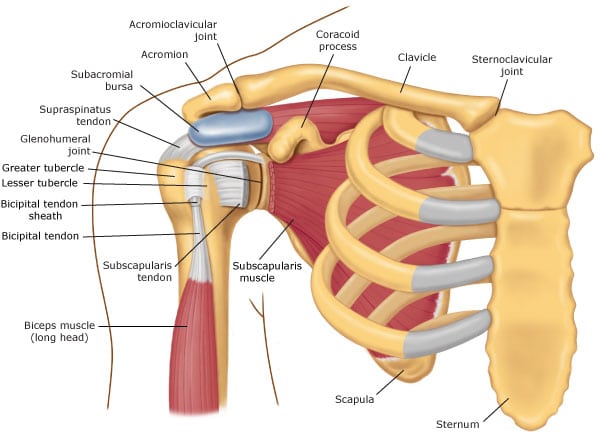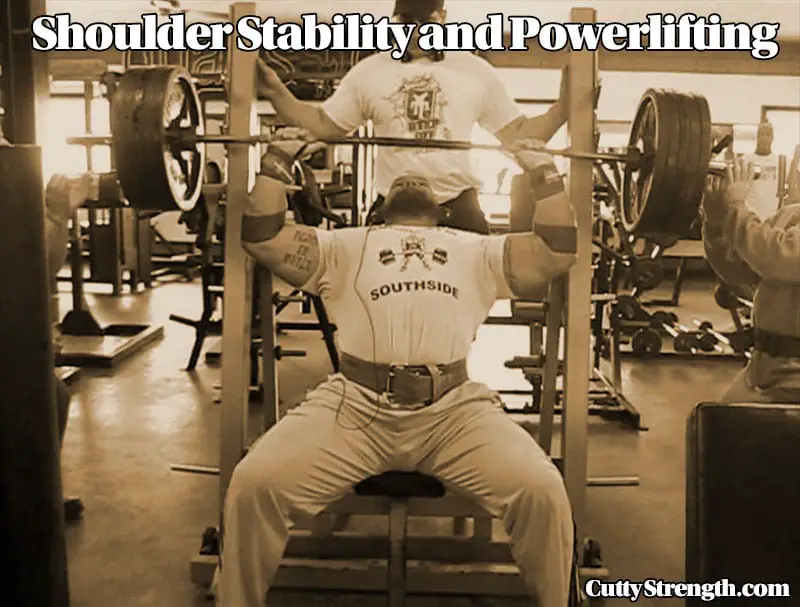In my quest to find out why my own body is failing me, I wanted to make something that I could share with everyone that would give first-hand experience along with scientific backing. This article started because of my Powerlifters Must Train Biceps article and while reading some ortho studies I saw that biceps also helped with shoulder stability.
A great deal of lifters have shoulder issues and when I started having them in 2013 I shrugged it off as something that’s inevitable and went about my training… Well 2 years later and I am having issues with every day movements.
Here is what I’ve come up with as a result of my researching to see why we have shoulder problems and what can we do to prevent or fix them from happening.
Shoulder Mechanics
The shoulder joint is called a ball and socket joint but this is also known as the Glenohumeral joint. The Glenohumeral joint is a ball and socket articulation between the head of the humerus and the glenoid cavity of the scapula. This means the ball on your humerus (arm) bone swivels inside the glenoid cavity of the scapula.

There are many joints, bones, ligaments, and tendons that work together and is usually called the shoulder complex. Since there is so much involved with a healthy shoulder, sports injuries are all too common.
What Causes Shoulder Issues?
From blunt trauma such as falling and dislocating to simple overuse, shoulder issues can occur for a number of reasons. For powerlifters, overuse, poor posture, and muscle imbalances wreck our shoulders.
Bench press, overhead press, dips, and any type of pressing puts a lot of strain on our shoulders. If we do not take precaution and do certain stretches, exercises, and mobility drills, we are setting ourselves up for failure down the road. Dips seem to cause strain and tear shoulders up more than any other exercise.
Signs of Shoulder Instability
Signs you have some stability issues in your shoulders may be clicking, clunking, or popping in the shoulder during certain movements. You may or may not have a loss of power in that side and a feeling of weakness especially pressing.
You might have pain from firmly touching the front or back of the shoulder joint and feel some impingement or apprehension during full range movement. There may also be pain when sleeping on that side.
Muscle Imbalances
A lot of powerlifters including myself have muscle imbalances either from poor programming or genetics. These muscle imbalances occur because we do not do enough antagonist work. Ideally being able to barbell row as much as you can bench press is a great goal to have.
One thing that I’ve noticed looking at forums and asking other lifters is that there are few who actually train biceps directly. This is something that I think needs to be changed if we want to be able to train for a long time.
Over-developed triceps and front delts mixed with weak biceps and rear delts causes a lot of problems in the shoulder. Mix in these other issues I’m about to go over and you have a recipe for pain.
Weak Muscles
Having weak scapula, biceps, delts, or the smaller muscles inside of your shoulder causes instability and possible injury.
The long head of the bicep helps keep the shoulder stable and “in place.” If I hold my arm straight out to my side, bend the elbow about 90 degrees and move in the limited mobility I have, I feel popping and some grinding. When I flex my bicep and do it again, I do not hear or feel any of this. I never would have thought that stronger biceps would in fact help with shoulder safety and stability.
Limited Mobility
If you’ve been a desk jockey or an inactive individual for the majority of your life, you have limited mobility in your scapula and shoulders. This limited mobility is dangerous when pressing heavy ass weight; one small mishap and you have a shoulder injury from something that shouldn’t be a problem for a fully functioning body.
Increasing mobility all over your body is extremely important if you want to ensure health and prosperity in your training.
Poor Posture
Being a desk jockey like me is the worst thing you can do for your body. Having poor posture leads to muscle imbalances, limited mobility, and much worse if you do not spend time correcting it. Muscles that need to be loose are tonic and muscles that should be tonic and strong are weakened and loose.
In the age of the computer and cubicles, poor posture seems to be one of the most widespread reasons for injuries or non-optimal performance.
Repetitive Strain
Loose ligaments in your shoulder can be from injuries, poor posture, or from normal anatomy. A lot of issues come from the repetitive overhead and pressing work that powerlifters do.
Looser ligaments make it harder to maintain shoulder stability and when you have a repetitive (reps) or stressful activities on your shoulder all of the time, it causes painful wrecked shoulders.
Physical therapy and shoulder strengthening exercises are something that need to be looked into. I highly advise contacting a therapist and getting your shoulders checked out if you are having issues with them. They will be able to put you on the path to success.
Common Shoulder Injuries
Rotator Cuff Injuries
The majority of shoulder problems in athletes and the general population are related to rotator cuff dysfunction. Repetitive trauma leading to inflammation is one causative factor in RTC injury, potentially leading to a tear of the RTC musculature. It should also be noted that RTC tears can be present and completely asymptomatic, meaning there is no pain. This was demonstrated in a large observational study in the general population.
Impingement
This is an encroachment of the subacromial space on the supraspinatus and often the biceps tendon, as well. RTC impingement can be a result of mechanical wear of the cuff under the coracoacromial arch. This has been described as a primary cause. Other contributing causes are degenerative changes to the RTC (which is inevitable as we age) and also an abnormal pathology of the acromion (structural defect).
Reference: http://www.askmen.com/sports/bodybuilding/shoulder-exercises-2.html
Overall Contributing Factors of Developing Shoulder Instability
- Fatigue
- Inadequate warm up
- Poor Posture
- Previous shoulder injury or dislocation
- Inadequate shoulder rehab post-injury
- Muscle imbalance
- Muscle weakness
- Thoracic spine tightness
- Poor core strength and stability
- Bad form (snap city)
- Shoulder joint hyper mobility
- Genetic ligament looseness
Conclusion
While this article didn’t include extensive studies, I wanted to make you aware of why shoulders are fragile and we need to take care of them. I hope that you take my advice and do more studying and practicing healthy habits to keep healthy shoulders. It seems once they are injured, it is hard to rehab back to what they were, if not impossible to get them back to where they were.
I’ve included all of the references that I’ve read so you can check them out and make your own conclusions. I will be doing much more needed mobility and antagonistic training work since my posture is bad and has created very limited mobility in much of my body.
Shoulder Stability Exercises:
- Gymnastics Training
- Rotator Cuff and Shoulder Conditioning Program PDF by American Academy of Orthopedic Surgeons
- http://www.askmen.com/sports/bodybuilding/shoulder-exercises.html
- http://www.muscleandfitness.com/workouts/shoulders-exercises/seven-phase-workout-protect-your-shoulders
References
- http://www.orthop.washington.edu/?q=patient-care/articles/shoulder/about-the-mechanics-of-shoulder-stability.html
- http://orthoinfo.aaos.org/topic.cfm?topic=a00529
- http://www.marksdailyapple.com/how-to-maintain-shoulder-mobility-and-scapular-stability/#axzz3TzgSuo7Q
- http://www.physioadvisor.com.au/10660350/shoulder-instability-shoulder-subluxation-phys.htm
- http://www.askmen.com/sports/bodybuilding/shoulder-exercises.html
- http://breakingmuscle.com/kettlebells/7-exercises-to-optimize-shoulder-health-with-kettlebells
- http://functionalresistancetraining.com/exercises/shoulder-stability-exercises
- http://www.muscleandfitness.com/workouts/shoulders-exercises/seven-phase-workout-protect-your-shoulders
- http://www.orthop.washington.edu/?q=patient-care/articles/shoulder/home-exercises-for-the-unstable-shoulder.html
- http://www.physioadvisor.com.au/16429050/scapular-stability-exercises-shoulder-blade-exer.htm
How close has this article hit close to home? Let me know in the comments.
